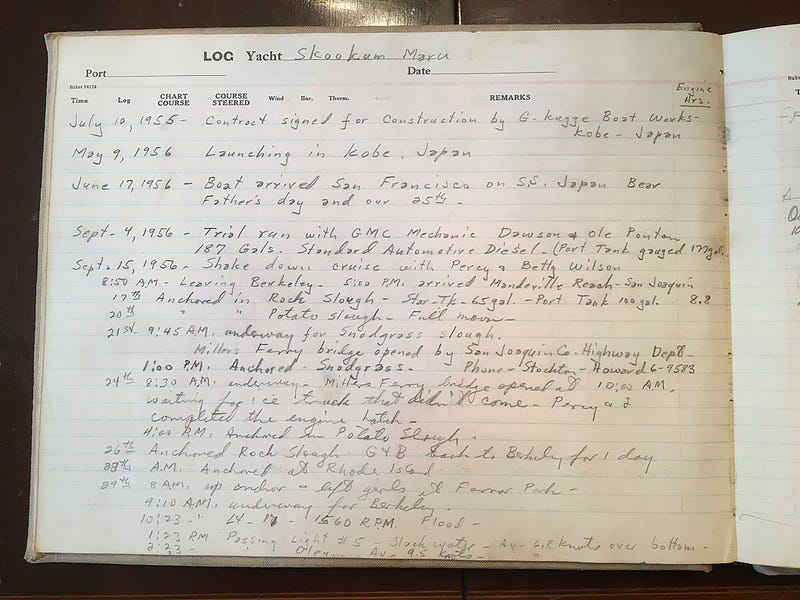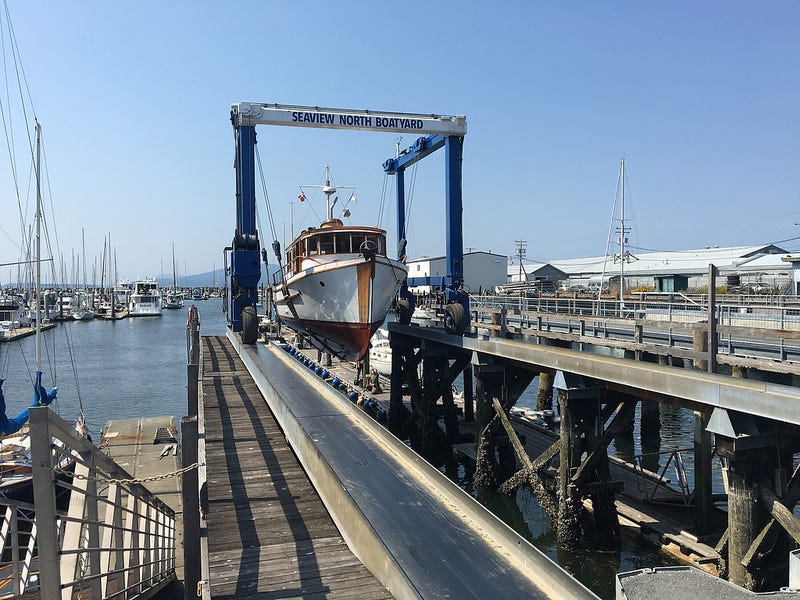Skookum Maru’s original log book, which we have in our possession through a series of improbably serendipitous events, includes this first entry:
"July 10, 1955. Contract signed for construction by G. Kugge Boat Works - Kobe - Japan"
That line records the moment when Skookum Maru began her existence as a thing of wood and metal. But the real beginning must have happened some time before then, in the first meeting between Ed Monk Sr. and his clients Gordon and Blanche Rogers, to commission a design for a new boat that they would have built for them in Japan.
Sadly, all correspondence from that process was lost in a long ago house fire. It would have made fascinating reading. But we do have her original plans and construction drawings, which show a “diesel cruiser” designed for extended passagemaking. She has a roomy wheelhouse, a large galley situated in the salon where the cook can enjoy the view while underway, a comfortable dining area, and generous accommodations, all rendered with Ed Monk’s particular eye for line.
She is not large, at just under forty feet length-on-deck, but her living spaces are well-proportioned and comfortable, with no attempt to shoehorn in a washer and dryer, an ice maker, a television, or any of the other “necessities” of a modern boat her size. Other boats since have taken these ideas and expanded on them, for better or worse, but Skookum Maru was one of the first trawler yachts, or heavy cruisers as Ed Monk called them.
The yard in Japan made fast work, and less than eight months later, in May of 1956, she was launched and then put on the freighter S.S. Japan Bear for shipment to the U.S. There the log continues, recording her arrival in San Francisco, commissioning and trial cruises by the Rogers’ and various friends, and then the first cruise up the West Coast to Victoria B.C., and ultimately to Seattle which would be her home port for most of the next sixty years, interspersed with regular cruises as far south as Cabo, Mexico and north to Alaska - a journey that she was to make many times over the following decades.
Skookum Maru is a name that combines the Chinook word “skookum” meaning strong or brave, with the Japanese word “maru”, which means castle, but which is also traditionally used in Japanese boat names. “Strong castle” - a good name for a vessel that will take you away from the safety of land and onto the uncertain and shifting sea, where the hope of safe return relies entirely on the stoutness of her timbers, the steady beat of her engine, and her ability to keep the water out.
She is well named. Her varnish is applied sparingly. She has no polished brass. She has none of the glamour of a classic yacht. But she is every bit a proper little ship - a boat to trust when the wind is blowing a full gale and the green water is flying over the bow. Her virtues are such that Robert Beebe included her in Voyaging Under Power, the first serious book about long distance powerboat cruising.
Gordon and Blanche Rogers logged many thousands of miles aboard Skookum Maru, owning her until Gordon passed away in the late nineteen eighties. Over the next twenty years she continued cruising the northwest with a series of owners who kept her very much as Gordon and Blanche had intended. There were minor changes - a propane range replaced the original diesel stove in the galley, the generator was removed, a new heating system was added - but her character remained intact.
In the fall of 2017, after spending several years attempting to restore an old fishing boat, we had learned that old fishing boats do not make good family cruising boats, being loud, uncomfortable, and unsafe for preschool-aged children. We were searching for a way to remedy these difficulties when Paul and Kim, the owners of Skookum Maru, reached out to suggest that we should buy her. The idea was absurd. We had a four-year-old son, a hundred-year-old house, and an income that could only generously be described as “intermittent” from my work as an independent software developer. Yet Paul said we should go look at her and then talk.
So on a gray December day toward the end of 2017 we drove up to Blaine and spent a few hours aboard. And fell completely in love. She was everything that our boat, Petrel, was not; comfortable, spacious, and in immaculate condition. She was a real cruising boat, but still with the workboat aesthetic that we liked in Petrel. We didn’t know how we would afford to buy her, but we would find a way.
Paul and Kim wanted to continue cruising Skookum Maru through the following summer before transferring ownership so we agreed to complete the sale in August of 2018, in time for us to take her on our annual wedding anniversary trip to the San Juan Islands. But before we could buy Skookum Maru we had to have her surveyed. So at the end of July, Paul and I ferried her down to Bellingham for the haulout and survey.
At first the survey indicated that she was in great shape. There were a few spots of soft wood in the house and deck to address in time, but nothing urgent. The hull planking and frames were in excellent condition. The last step was to perform a fastener inspection, in which hull fasteners are removed from several places to check their condition. At which point we found that there was little holding the planks to the frames but memory and promises. The original iron nails and galvanized screws were far beyond their service life. Skookum Maru needed to be refastened.
Refastening requires that all of the many screws holding the hull together be replaced. It is a significant effort that can require thousands of dollars and weeks out of water. But we had spent too many months daydreaming about cruising aboard Skookum Maru to be turned back. We thought hard for perhaps all of five minutes before deciding to proceed with the purchase and take on the refastening project.
We had a new boat, but first we had to get her from Blaine, where she was moored, to Seattle, where we wanted to do the work. Through a combination of luck and negotiation we were able to find a shipwright that we trusted to do the work on short notice, schedule the haulout, and make all of the necessary arrangements so that we could take our wedding anniversary cruise at the same time.
So an a sunny Friday in August, we crossed left Blaine Harbor on our first family cruise aboard Skookum Maru. The wind was light, the water flat calm, the sky was clear and the Strait of Georgia stretched out north behind Vancouver Island - a smooth highway all the way to Desolation Sound if we only had time to take it. But not that day. We were on a deadline to make it to Seattle in time for the haulout on Monday, and our course lay south.
Over the next three days we enjoyed a wedding anniversary dinner in Friday Harbor, dodged thunderstorms on the way across the Strait of Juan de Fuca to Port Townsend, and had an uneventful run down Puget Sound to Seattle and the Ballard Locks, the entry point to the Lake Washington Ship Canal and the yard where we were scheduled to haul out in the morning.
Just as we were heading into the locks a man on the lock wall began waving and calling to us. He recognized the boat and said that he had her original log book, which he had received years before from her long-time former owners. We let him know where we would be hauled out, and a few days later he brought us the book, which records the first step in the creation of the motor vessel Skookum Maru.
We had a boat suitable for a family, but there was a lot of work to be done before we would be able to go cruising aboard her.








This is so wonderful to read! Gordon and Blanche Rogers were my great uncle and aunt, Gordon being my grandmother’s brother. I have precious memories of them and of the Skookum. When I was 12 or 13 years old, we spent a week on her, fishing for salmon and exploring Pender Harbor, Princess Louisa Inlet, and other parts of the Sunshine Coast. I can still see it all in my minds eye. What a treasure!
Sweet story of a timeless vessel😎